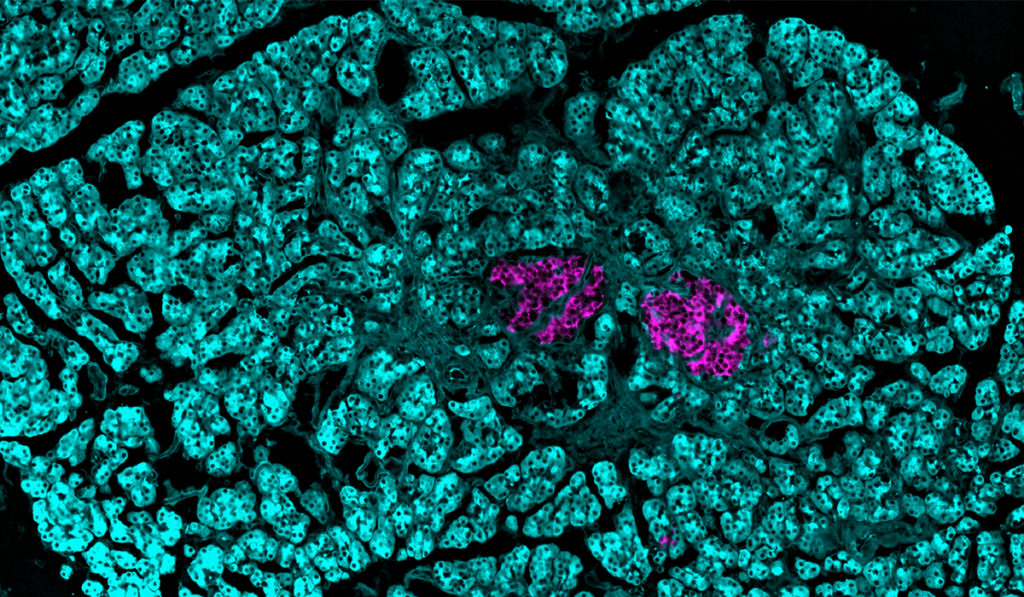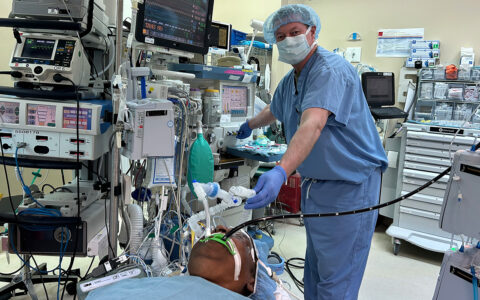Pancreas volume is reduced in people with type 1 diabetes (T1D) because the organ contains fewer exocrine cells, according to a study at Vanderbilt University Medical Center. The findings refine the basic anatomy of the diabetic pancreas and could lead to improved prevention and treatment.
“We have recognized for some time that in type 1 diabetes the pancreas is smaller, but the reason was a mystery,” said Jordan J. Wright, M.D., an instructor at Vanderbilt and first author of the study, which was published in Diabetologia.1
“We have recognized for some time that in type 1 diabetes the pancreas is smaller, but the reason was a mystery.”
The pancreas has an endocrine compartment that produces hormones like insulin and an exocrine compartment that produces digestive enzymes. Although the organ’s insulin-producing beta cells are destroyed in diabetes, those cells account for only 2 percent of the pancreas’s total volume, Wright said. The remaining 98 percent is comprised of acinar cells dedicated to production of digestive enzymes.
“Since type 1 diabetes was thought to only affect the beta cells of the islet, we were surprised at how much smaller the diabetic pancreas is. We knew that the small size couldn’t be accounted for just by the loss of the beta cells,” Wright said.
Comparing Donor Pancreases
The researchers compared 31 pancreases from adult donors who had T1D to 36 pancreases from donors who did not have the disease. They assessed the organs for cell size, composition of the endocrine and exocrine compartments, and the degree of fibrosis.
“A reduction in exocrine cell number, rather than cell size, accounted for the 45 percent difference in pancreas volume between diabetic and non-diabetic donors,” Wright said. “Exocrine cell size did not vary.”
The researchers also found greater fibrosis in the extracellular matrix of diabetic organs. “These findings show that type 1 diabetes is a disease of the entire pancreas. It affects both the endocrine and the exocrine compartments.”
“Type 1 diabetes is a disease of the entire pancreas. It affects both the endocrine and the exocrine compartments.”
Enigmas in the Findings
To investigate possible causes, Wright and colleagues studied mice with various forms of insulin deficiency seen in T1D. They thought that the lack of insulin might lead to a reduced pancreas size. However, pancreas size was not affected in three models. More research is needed to understand why there is a difference in human diabetes, Wright says.
Additionally, within the human pancreases the researchers found disease duration did not have the expected effect upon pancreas size. “All the donors had diabetes for at least six years, but whether they had had the illness for six years or 40 years, the pancreas size was similar,” Wright said. “This shows that important changes are happening very early in the disease process.”
An Inroad for Early Intervention?
The team is now working to better understand the timing of these early changes in the disease. They are evaluating MRI images of pancreases of individuals who are at high risk for developing T1D because of their family history or other risk factors. Wright believes early anatomic changes in the pancreas, in combination with other clinical factors, could help guide prevention trials by identifying high-risk individuals prior to onset of clinical disease.
Said Wright, “We need to better understand what is happening at those early stages as we work to develop more targeted prevention and treatment strategies.”




